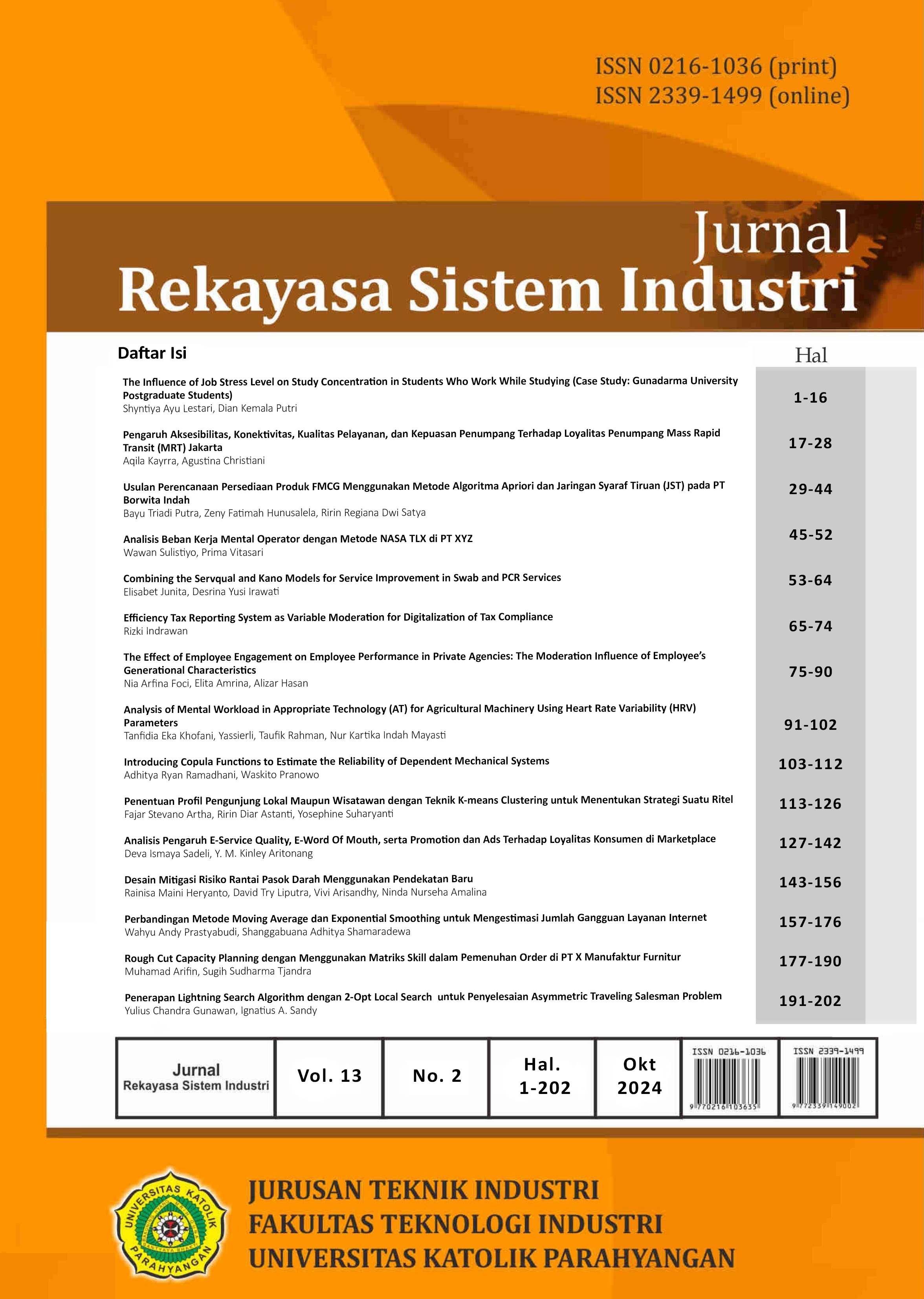Comparison of Moving Average and Exponential Smoothing Methods for Estimating the Number of Internet Service Disruptions
DOI:
https://doi.org/10.26593/jrsi.v13i2.7609.157-176Keywords:
Forecasting, service interuption, moving average, single exponential smoothingAbstract
Fairly tight competition in telecommunication business requires companies to continue improving the quality of their services, including handling network problems or customer complaints. However, the amount of disturbance that occurs is often unpredictable. Indeed, this condition will impact the allocation of resources and budget for handling customer disturbances in the following period, with uncertainty. This research aims to apply the moving average (MA) and single exponential smoothing (SES) forecasting methods to predict the number of internet service disruptions. The case study used in this paper is an internet service provider company with service coverage in the northern part of Surabaya. The number of disturbances data was collected from January 2022 to May 2022, with 18,453 data in total. The disturbances can be divided into five types: physical, mass, logical, PSB/migration, and others. Forecasting is carried out using the MA method with a period of three months. Meanwhile, forecasting using the SES method was carried out by first determining the alpha value that produces the smallest Mean Absolute Percentage Error (MAPE) value. The analysis results show that both forecasting methods are relatively effective and efficient in estimating the number of disturbances. Forecasting performance testing was carried out by measuring the Mean Absolute Deviation (MAD), Mean Square Error (MSE), and Mean Absolute Percentage Error (MAPE) values. The results of forecasting performance measurements show that the SES method is much better than MA for all types of disturbance data, with MAPE values below 2%.
References
Aden, A. (2020). Forecasting The Eksponential Smoothing Methods.
Andini, T. D., & Auristandi, P. (2016). Peramalan Jumlah Stok Alat Tulis Kantor di UD Achmad Jaya Menggunakan Metode Double Exponential Smoothing. Jurnal Ilmiah Teknologi Informasi Asia, 10(1).
Asynari, E., Wahyudi, D., & Aeni, Q. (2020). Analisis Peramalan Permintaan Pada Geprek Bensu Menggunakan Meode Time Series. Teknologi Dan Sistem Informasi, VI(3).
Gustriansyah, R., Nadia, W., & Sofiana, M. (2019). Komparasi Metode Peramalan Jumlah Permintaan Kamar Hotel. Jurnal Ilmiah Informatika Global, 9(2). https://doi.org/10.36982/jig.v9i2.563
Hakimah, M., Rahmawati, W. M., & Afandi, A. Y. (2020). Pengukuran Kinerja Metode Peramalan Tipe Exponential Smoothing Dalam Parameter Terbaiknya. Network Engineering Research Operation, 5(1). https://doi.org/10.21107/nero.v5i1.150
Lusiana, A., & Yuliarty, P. (2020). Penerapan Metode Peramalan (Forecasting) Pada Permintaan Atap di PT X. Industri Inovatif : Jurnal Teknik Industri, 10(1). https://doi.org/10.36040/industri.v10i1.2530
Nugraha, E. Y., & Suletra, I. W. (2017). Analisis Metode Peramalan Permintaan Terbaik Produk Oxycan pada PT. Samator Gresik. Seminar Dan Konferensi Nasional IDEC.
Nabillah, I., & Ranggadara, I. (2020). Mean absolute percentage error untuk evaluasi hasil prediksi komoditas laut. JOINS (Journal of Information System), 5(2), 250–255. https://doi.org/10.33633/joins.v5i2.3900
Rachman, R. (2018). Penerapan Metode Moving Average Dan Exponential Smoothing Pada Peramalan Produksi Industri Garment. Jurnal Informatika, 5(2). https://doi.org/10.31311/ji.v5i2.3309
Rahman, A. A., Supaidi, A., Aslamiah, I., & Ibrahim, A. (2018). Implementasi Customer Relationship Management (Crm) Pelayanan Pelanggan (Corporate) Divisi Bges Pada PT Telkom Witel Sumsel. JRMSI - Jurnal Riset Manajemen Sains Indonesia, 9(1). https://doi.org/10.21009/jrmsi.009.1.05
Ramdani, D. A., & Azizah, F. N. (2021). Metode Peramalan moving Average, 1000 Analisis Perbandingan Peramalan Permintaan Pelumas Pt Xyz Dengan Metode Moving Average, Exponential Smoothing Dan Naive Method. Seminar Nasional Official Statistics, 2020(1). https://doi.org/10.34123/semnasoffstat.v2020i1.576
Septiyana, D., & Bahtiar, A. (2020). USULAN Perbaikan Peramalan Produksi Ban Pt. Xyz Melalui Pendekatan Metode Exponential Smoothing. Journal Industrial Manufacturing, 5(1). https://doi.org/10.31000/jim.v5i1.2444
Sudiman, S. (2020). Peramalan Untuk Perencanaan Produksi Stop Valve Tipe Tx277s Menggunakan Metode Peramalan Deret Waktu (Time Series) Di PT. XYZ. JITMI (Jurnal Ilmiah Teknik Dan Manajemen Industri), 3(1). https://doi.org/10.32493/jitmi.v3i1.y2020.p7-14
Supriyanto, W. (2019). Strategi Komunikasi Internal PDAM Tirta Satria Mengatasi Keluhan Pelanggan. Warta ISKI, 2(01). https://doi.org/10.25008/wartaiski.v2i01.27
Yudiarti, & Wira, W. (2019). Perbandingan Metode Peramalan Penjualan Semen Menggunakan Moving Average Dan Single Exponential Smoothing. Jurnal Ilmiah Matematika, 7(3).
Zaman, S. N., Merlina, N., & Nurajijah, N. (2021). Sistem Informasi Keluhan Pelanggan Berbasis Website. Evolusi : Jurnal Sains Dan Manajemen, 9(1). https://doi.org/10.31294/evolusi.v9i1.9636

